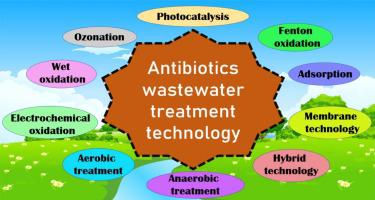Journal of Hazardous Materials ( IF 13.6 ) Pub Date : 2020-05-19 , DOI: 10.1016/j.jhazmat.2020.122961 Bao Lee Phoon , Chong Cheen Ong , Mohamed Shuaib Mohamed Saheed , Pau-Loke Show , Jo-Shu Chang , Tau Chuan Ling , Su Shiung Lam , Joon Ching Juan

|
Antibiotics and pharmaceuticals related products are used to enhance public health and quality of life. The wastewater that is produced from pharmaceutical industries still contains noticeable amount of antibiotics, and this has remained one of the major environmental problems facing public health. The conventional wastewater remediation approach employed by the pharmaceutical industries for the antibiotics wastewater removal is unable to remove the antibiotics completely. Besides, municipal and livestock wastewater also contain unmetabolized antibiotics released by human and animal, respectively. The antibiotic found in wastewater leads to antibiotic resistance challenges, also emergence of superbugs. Currently, numerous technological approaches have been developed to remove antibiotics from the wastewater. Therefore, it was imperative to critically review the weakness and strength of these current advanced technological approaches in use. Besides, the conventional methods for removal of antibiotics such as Klavaroti et al., Homem and Santos also discussed. Although, membrane treatment is discovered as the ultimate choice of approach, to completely remove the antibiotics, while the filtered antibiotics are still retained on the membrane. This study found, hybrid processes to be the best solution antibiotics removal from wastewater. Nevertheless, real-time monitoring system is also recommended to ascertain that, wastewater is cleared of antibiotics.
中文翻译:

从废水中去除抗生素的常规技术和新兴技术。
抗生素和药物相关产品用于增强公众健康和生活质量。制药行业产生的废水中仍然含有大量抗生素,这仍然是公共卫生面临的主要环境问题之一。制药业用于去除抗生素废水的常规废水修复方法无法完全去除抗生素。此外,市政和牲畜废水中还分别含有人和动物释放的未代谢的抗生素。废水中发现的抗生素导致抗生素耐药性挑战,也出现了超级细菌。当前,已经开发了许多技术方法来从废水中去除抗生素。因此,必须严格审查这些当前使用的先进技术方法的弱点和优势。此外,还讨论了常规的去除抗生素的方法,例如Klavaroti等人,Homem和Santos。尽管发现膜处理是完全去除抗生素的最终选择,但过滤后的抗生素仍保留在膜上。这项研究发现,混合工艺是从废水中去除抗生素的最佳解决方案。尽管如此,也建议使用实时监控系统,以确保废水中不含抗生素。虽然,膜处理是彻底去除抗生素的最终选择,但过滤后的抗生素仍保留在膜上。这项研究发现,混合工艺是从废水中去除抗生素的最佳解决方案。尽管如此,也建议使用实时监控系统,以确保废水中不含抗生素。尽管发现膜处理是完全去除抗生素的最终选择,但过滤后的抗生素仍保留在膜上。这项研究发现,混合工艺是从废水中去除抗生素的最佳解决方案。尽管如此,也建议使用实时监控系统,以确保废水中不含抗生素。



























 京公网安备 11010802027423号
京公网安备 11010802027423号